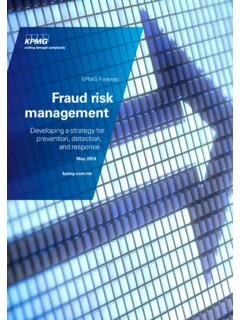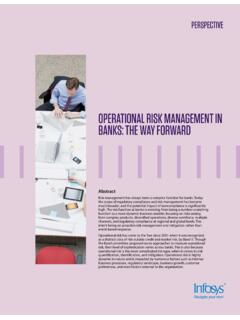Transcription of Integrated risk assurance - Get a clearer understanding of ...
1 Integrated risk assurance Get a clearer understanding of the risks affecting business value May 20182 Integrated risk assuranceContents An efficient framework for seeing the whole risk picture 01 defining the problem 03 Organizing according to a new principle 07 Following a different assurance cycle 11 There s no time like the present 191 Integrated risk assuranceAn efficient framework for seeing the whole risk picture Over the past decade, as financial, operational , strategic, cyber, reputational, and other risks have proliferated, organizations have been working on effective responses. Boards have placed risk oversight at the top of their agendas. Senior executives have upgraded the risk management infrastructure. Businesses and IT functions have adopted tools and solutions. Compliance, risk management, and chief audit executives have enhanced their functions capabilities. Yet many management teams, audit committees, and boards still lack a clear, accurate, and comprehensive picture of the truly greatest risks to their organization and of the risk management programs that protect the organization.
2 Ultimately, the purpose of risk frameworks and assurance activities is to strengthen an organization s controls to preserve shareholder value. From board directors to line managers, everyone occasionally loses sight of why these valuable governance mechanisms exist, relegating them to bureaucratic check-the-box exercises. The main barriers to creating a comprehensive risk picture are neither technological nor financial but rather organizational, particularly when it comes to risk assurance . The traditional ways in which assurance activities and reporting are organized limit an organization s visibility into risks and into the effectiveness of its risk management, while creating unnecessary costs and page has been intentionally left blank2 Integrated risk assurance3 Integrated risk assuranceDefining the problem Organizations have typically adopted new approaches to risk oversight and management in response to the most recent high-profile risk event in their organization or reported on the news, or in response to regulatory mandates.
3 This has often resulted in risk reporting that s best characterized as narrowly focused and diffused, redundant and costly, intrusive to the businesses and functions, and, least pleasant of all, unrelated to the true drivers of enterprise value and performance. If you re a senior executive or board member with risk-related responsibilities, consider these questions: Does the organization need to refocus on what really matters and clarify accountabilities for risk? Are assurance reports heavy on detail, but light on what those details mean? Is it difficult to reconcile the views you receive from various information sources for assurance ? Do people in the business experience assurance fatigue due to multiple requests from various assurance functions? Does the term assurance need a better definition, along with a better definition of assurance responsibilities? If you answered yes to any of these questions, it s time to consider Integrated risk assurance .
4 But first, it s important to understand the two significant challenges facing current practices:4 Integrated risk assurance - . Issue 1 Too much information, not enough insight Spurred by new regulatory mandates and the perceived need to mitigate all risks , there s been an explosion in assurance activities and reporting without an equivalent rise in insight on risks and risk management. Regulators and standard setters around the world have emphasized risk oversight and governance by boards and senior executives, and those overseers roles in reviewing the effectiveness of risk management, but the data and details resulting from these stronger risk-management and governance efforts don t coalesce into a coherent picture on their own. One response to these unconnected dots has been the development of the concept of combined assurance , which sought to take a fulsome view of all risk and controls in an organization. Combined assurance was first articulated in 2009 as a requirement for audit committees in South Africa s King III Corporate Governance IV: Bolder than ever, Deloitte South Africa, 2016 < >While the objective is conceptually sound, combined assurance efforts have often proven inadequate in providing what management needs.
5 Most efforts tend either to roll up existing assurance reports or to bog down in mapping exercises to identify and rationalize every assurance activity in the organization. Those flaws include burdensome, time-consuming activities geared mainly to assessing individual control, compliance, and risk management mechanisms and lack of attention to the big picture. These activities generate neither the insight into risks that boards and executive teams want nor the right levels of assurance on risk-management effectiveness. In practice, every organization needs a bespoke, fit-for-purpose approach to integrating risk assurance . The purpose will vary with the organization, and its industry, regulatory environment, business strategy, specific risks , and available resources. The entity s level of risk assurance maturity will also help determine the proper approach. Whatever the organizational needs are, a practical, enterprise-based approach to risk assurance must be rooted in the organization s specific drivers of value, the risks to those drivers, and ultimately in the needs of those relying on the assurance .
6 Good audit reports, but I can t see the forest for the trees Board Member5 Integrated risk assuranceIssue 2 Risk serves multiple masters Basic human instinct naturally drives us to manage risk in our personal lives. That instinct operates at an organizational level as well, but there the risks have various owners and overseers with different priorities and different risk- assurance needs. These owners and overseers include: Board and audit committee members who, as the ultimate overseers, require a clear view of risk; this view is often obscured by current methods of providing risk assurance The chief executive officer, who is responsible for implementing the strategies and achieving the performance goals that may be affected by risks and risk management The chief operating officer, who is directly accountable for decisions on operational performance and risk management The chief financial officer, who holds a major stake in the success of risk management as it affects financial performance and asset values The chief risk officer, who is responsible for supporting and overseeing risk management across the enterprise.
7 This requires useful, high-quality risk assurance The chief audit executive, who aims to improve oversight of reporting, internal control, and audit processes, and must understand the organization s risks and risk management activities Leaders must know what risks will affect their area of responsibility and who is ultimately accountable for managing those risks . However, a lack of coordination among risk assurance functions and a lack of consensus on what matters most in risk and risk assurance undermines efforts to develop an Integrated view. More often than not, the challenge is that the complex risks overlap and accountability for them either sits with too many or no one at all. Risk Board & audit committee Chief financial officer Chief risk officer Chief executive officer Chief audit executive Chief operating executiveThis page has been intentionally left blank6 Integrated risk assurance7 Integrated risk assuranceOrganizing according to a new principle A fit-for-purpose approach to integrating risk assurance begins and ends with understanding the business drivers that preserve and enhance organizational value.
8 Because every organization has a unique set of value drivers, each will have unique ways of defining , assessing, tracking, and addressing risks , and a unique set of processes for providing assurance . As an organizing principle, the value drivers orient establishments toward what matters most and align risk assurance efforts to be targeted, efficient, and insightful. Once these value drivers are defined, understood, and embraced, they set the foundation for how risk assurance activities are prioritized, planned, coordinated, and delivered and they also set the foundation for assurance reporting. The Integrated risk assurance framework summarizes this approach (Exhibit 1).8 BUSINESS DRIVERS infographicIntegrated risk assuranceExhibit 1: Integrated risk assurance frameworkValueBUSINESS DRIVERSEXTERNAL BUSINESS ENVIRONMENTBUSINESS STRATEGYOPERATIONAL PERFORMANCEP rincipal risksRisk responsesEnhanced executionUnifiied reporting & monitoringRisk themes9 Integrated risk assuranceBuilding from the inside out, this framework provides context for aligning risk assurance with enterprise value: Layer 1: Start with the business drivers of value To address the risks that matter most, Integrated risk assurance starts with a focus on enterprise value and the business drivers of that value.
9 These are typically shaped by a company s business strategy, operational performance, and external business environment. Each of these must be clearly defined and understood to ensure the Integrated risk assurance model is organized so that risk assurance itself adds value. Layer 2: Understand the underlying principal risks Integrated risk assurance then identifies and assesses the risks that most jeopardize or enhance the business drivers of value; that is, those most likely to negatively or positively affect business outcomes. This analysis determines the required levels of assurance based on the organization s risk appetite and the expectations of its stakeholders customers, partners, regulators, shareholders, and employees. Layer 3: Plan and execute the risk assurance cycle This model of risk assurance organizes reporting around risk themes: groupings of similar or related risks that can most affect the drivers of value. Those drivers also dictate the assurance priorities that need to align with business strategy and operations.
10 The risk themes will then guide decisions about assurance planning and execution so that resources are optimally allocated and reporting and monitoring are page has been intentionally left blank10 Integrated risk assurance11 Integrated risk assuranceFollowing a different assurance cycle A compelling case for initiating Integrated risk assurance can be made by examining the assurance cycle, or the outer rim of the Integrated risk assurance framework. This is where risk assurance activities must be organized, resources coordinated, and reporting reimagined: 1. Targeted risk themes for assurance planning come primarily from framing the business drivers of value to define the risk themes that support the strategic imperatives of the enterprise. Common assurance planning on what matters can be organized in this stage. Where appropriate, information from the enterprise risk management (ERM) system and other sources may be used to enhance existing risk knowledge.













